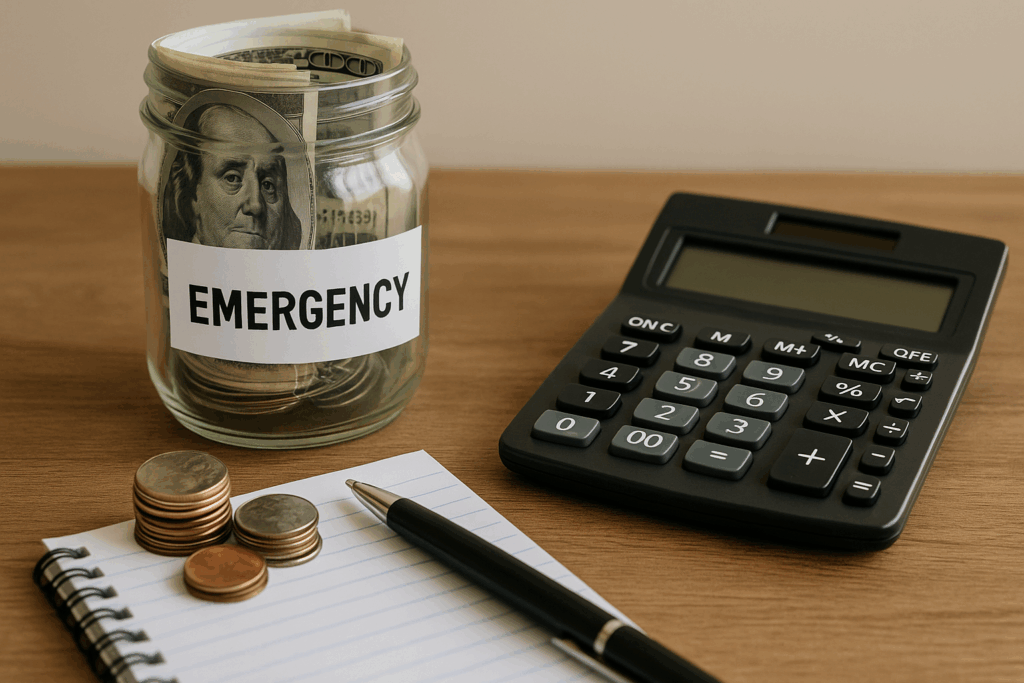Amppfy Takeaways
- Calculate your personalized target by totaling your essential monthly expenses and multiplying by your desired coverage period (3–6 months for most, 9–12+ months if you face higher job or family risk).
- Kick off with a small “starter” goal (e.g., $500–$1,000) to handle minor emergencies and build confidence before scaling up to full coverage.
- Automate regular contributions. Set up weekly or monthly transfers into a separate emergency-fund account so you can save without thinking about it.
- Choose the right liquid account and boost your rate: use high-yield savings or money-market accounts for full liquidity (APYs around 4.00–4.40%), and consider laddered short-term CDs for incremental yield on portions of your fund.
An emergency fund is your money cushion. It’s made to cover unexpected costs, like medical bills, car repairs, or a sudden job loss, without using high interest debt or investing in long-term investments. Experts usually suggest saving three to six months of important living expenses. But people in risky jobs or with families may want to save nine to twelve months, or even twelve to eighteen months in extreme cases. By adding up your monthly costs and the time you want to be covered, you can set a goal for yourself and make a plan to reach it. Building this fund in stages—starting with a small “starter” goal, automating contributions, and choosing the right interest‑bearing account—turns an intimidating total into an achievable journey toward financial security.
What Is an Emergency Fund?
An emergency fund is a liquid pool of cash set aside exclusively for unplanned costs such as urgent medical care, home repairs, or loss of income. Unlike retirement or investment accounts, these funds are in accounts that you can access right away and have little risk. This means that your money stays safe and available when you need it most. By putting this money in a separate account from your regular checking or brokerage accounts, you won’t want to spend it on things you don’t need. You’ll also keep your long-term savings plan.
Why You Need an Emergency Fund
Unexpected costs can quickly derail your financial plan. The average U.S. household spent $77,280 in 2023, with housing, transportation, and food comprising the bulk of this outlay. Without a dedicated cash reserve, individuals often turn to credit cards or payday loans—incurring high interest rates—or liquidate retirement savings early, triggering taxes, penalties, and lost market growth. Furthermore, the typical U.S. job search now lasts about 23.7 weeks, meaning lost income can extend well beyond a single paycheck. An emergency fund provides the breathing room needed to address these shocks without compromising your long‑term financial health.
Calculating Your Emergency Fund
Standard Rule of Thumb
Financial planners generally advise saving three to six months of essential living expenses as a starting point. Three months may be enough for families with two incomes with steady jobs. Six months is a safer choice for single earners or those in uncertain fields.
Factors That Affect Your Target
- Job Stability & Industry Risk: If your sector—such as technology or energy—is prone to layoffs, consider nine to twelve months of coverage to ride out downturns.
- Household Size & Dependents: Larger households incur higher fixed costs (e.g., childcare, health insurance), warranting a larger fund.
- Income Diversity: Dual‑earner families can lean toward three months, whereas single earners should aim for six to twelve months.
- Personal situations: Factors like health issues or pending life events may prompt you to save toward the higher end of the range.
Simple Formula and Online Calculators
Use the straightforward formula:
Emergency Fund = Average Monthly Expenses × Desired Months of Coverage
Emergency Fund Calculator Examples
- Baseline Case: If your monthly expenses are $4,000 and you want six months’ coverage, your target is:
$4,000 × 6 = $24,000
- Conservative Case: A technology professional facing potential layoffs might aim for nine months, equating to:
$4,000 × 9 = $36,000
- Starter Fund: Before reaching full coverage, set an initial goal of $500–$1,000 to handle minor emergencies—like a car repair or small medical bill—and build confidence.
Building Your Emergency Fund
Start with Small, Achievable Milestones
Break down your goal into smaller targets—$500, then $1,000, then three months’ expenses—to maintain motivation and track progress.
Automate Your Savings
Schedule recurring transfers from checking to a dedicated emergency fund account—weekly or monthly—to make saving effortless and consistent.
Boost Contributions
Free up extra cash by reducing discretionary expenses (e.g., dining out, subscriptions) or pursuing side gigs—ridesharing, freelancing, pet sitting—that can add $200–$500 per month to your fund.
Choose the Right Account
- High‑Yield Savings Accounts: Offer competitive 4.00%–4.40% (APYs) with full liquidity for balances under $250,000.
- Money Market Accounts: Provide check‑writing benefits and slightly higher yields, though they may require higher minimums.
- Certificates of Deposit (CDs): Use a laddered approach—keeping most funds liquid while locking portions in short‑term CDs for incremental yield boosts.
Turn Financial Anxiety into Confidence with a Smart Emergency Fund
An emergency fund is your first line of defense against life’s financial surprises. By accurately calculating your needs—either through the simple “expenses × months” formula or via robust online calculators—and by building your fund in stages with automation and the right account choices, you can transform financial anxiety into confidence. Start today with a small goal, and you’ll be ready for anything.

